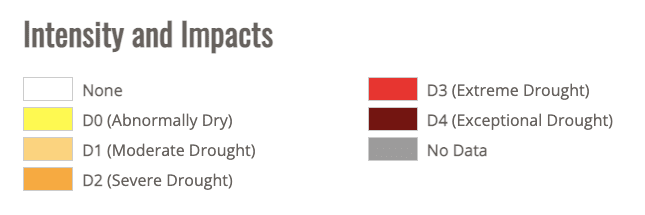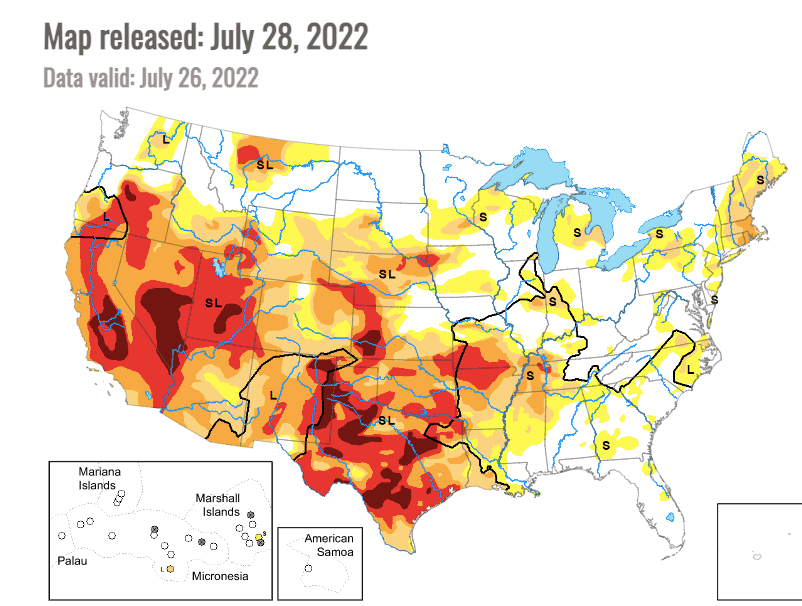
![]() See Bahasa Indonesia translation
See Bahasa Indonesia translation
104th Edition : July 2022
Key Points
- Foot & Mouth Disease continues to spread throughout Indonesia.
- Vaccination progress disappointingly slow.
- Australian cattle prices declining sharply.
Indonesia : Slaughter Steers AUD $5.15/kg live weight (Rp10,300 = $1AUD)
Foot and Mouth Disease (FMD) continues to be the main driving force for the live cattle and beef dynamics across Indonesia. Multiple random FMD emergency slaughter events in the main cattle production areas of Java and Sumatra has resulted in extreme volatility in live cattle prices although rates for retail beef have been less affected. A combination of low vaccination numbers, inadequate compensation and poor organisation of the epidemic control efforts has allowed the disease to continue to spread throughout much of the remaining vulnerable livestock population.
Wild supply fluctuations have pushed live fat cattle prices in a range from as low as Rp15,000 for emergency slaughter downers to Rp59,000 for the very best quality disease free steers and bulls. As a general average I have used Rp53,000 per kg live as this month’s indicator rate although this is only available for healthy cattle which are free to move to an abattoir.
Indian Buffalo Meat (IBM) continues to sell well with monthly volumes at 10-12,000 tons. Prices remain amazingly high at Rp129,000 per kg despite an import price of about half that value. Something is not right here.
Small-holder cattle owners are reluctant to report infection as they are not confident of getting adequate compensation preferring to send their suspect cattle to slaughter even if it means a discount price.
See below the official process for claiming compensation for compulsory slaughter of FMD infected animals.
- Affected breeder must attach a photocopy of his/her/group ID card.
- The animals must have been recorded and reported by the animal husbandry and animal health service to the digital animal health information system (iSIKHNAS)
- Owner must provide certificate of animal ownership signed by the local village or sub-district head
- Owner must attach Stamping out Certificate issued by local veterinarian
 The mix of government departments, the police and military controlling livestock movement restrictions appears to have been poorly coordinated resulting in different restrictions in different areas depending on who is in charge. Numbers of vaccinators has been insufficient with police and army undergoing training to support this role. Once again, the organisation of this response has resulted in confusion and resistance. A new ear tag using QR code technology is under development in Indonesia but as yet is unavailable, so identification of animals vaccinated to date is in many cases unreliable. The authorities are still making it virtually impossible for private enterprise to import and deliver their own vaccine. In summary, the response to the outbreak so far has been chaotic, largely ineffective and if anything has potentially promoted the spread of the disease.
The mix of government departments, the police and military controlling livestock movement restrictions appears to have been poorly coordinated resulting in different restrictions in different areas depending on who is in charge. Numbers of vaccinators has been insufficient with police and army undergoing training to support this role. Once again, the organisation of this response has resulted in confusion and resistance. A new ear tag using QR code technology is under development in Indonesia but as yet is unavailable, so identification of animals vaccinated to date is in many cases unreliable. The authorities are still making it virtually impossible for private enterprise to import and deliver their own vaccine. In summary, the response to the outbreak so far has been chaotic, largely ineffective and if anything has potentially promoted the spread of the disease.
Initially 3 million doses of FMD vaccine were imported with 800,000 distributed in June. Most of those have now been delivered to stock while the remaining 2.2 million doses were released for use towards the end of July. The problem now is getting these new doses into animals quickly and efficiently. With plans to use police, military and veterinary students for additional vaccination capacity it seems strange that the Australian government has not been asked to contribute to the manpower and resources needed for this rapid vaccination effort. The Australian Minister for Agriculture has made a number of offers of support, but diplomatic protocols make it impossible to find out why Indonesia doesn’t want more help. From my personal perspective, why not let Australia fund and support the vaccination program in Bali? This would allow scarce resources to be used elsewhere in Indonesia while the Bali effort would deliver the best protection for both Bali and the Australian industry.
At the end of July the national total vaccination numbers stood at around 1 million doses with about 30,000 doses injected in Bali.
The Australian government has finally agreed to install footbaths in all airports receiving direct flights from Bali.
The Indonesian government has established a website which provides live data on the progress of the FMD outbreak. See a screen shot below from the 30th July.
It is an open source at https://siagapmk.crisis-center.id/
Despite a very large number of requests for information we are still yet to find out the origin of the FMD virus. Was it from smuggled animals from Malaysia or infected Indian buffalo meat or some other source? There have been a few newspaper articles discussing this but we need scientific proof not press articles to tell us exactly the source of the virus. It is a very simple matter to identify the genetic code of the virus currently raging throughout Indonesia and match it with the genetic code of the potential sources. It’s a 24 hour job for a specialist lab. Why is this essential piece of routine disease investigation information such a tightly kept secret?
Lumpy Skin Disease (LSD).
This extremely important disease is taking a back seat due to its apparent failure to spread out of central and northern Sumatra. I have suggested that this is possibly due to the direction of the current northeast monsoonal winds preventing the virus carrying insects from moving to the south. We only have to wait until October when the winds reverse and begin to come from the north to find out if this proposition is correct or not.
Darwin feeder steer prices have seen a significant collapse during July. Prices have slipped from around $4.80 in June to $3.85 at the end of July due mainly to poor seasonal conditions in northern Australia leading to a sudden shortage of grass. This would normally be extremely attractive for Indonesian importers if it wasn’t for FMD and the lack of vaccine to protect stock on arrival. Despite the extreme risk for feeders arriving into a raging FMD epidemic, a total of 4 shipments carrying 9900 head left from Darwin during July with two heading for Medan in North Sumatra and two discharging in Lampung in South Sumatra. The longer it takes to protect the Indonesian herd with broad vaccination coverage, the more heavy cattle will have to be emergency slaughtered. Considering the poor response to date, it appears that a very large number of heavy cattle will have disappeared from the market by the end of this year leaving a massive gap in supply for 2023.
Vietnam : Slaughter Steers AUD $5.44 / kg (VND16,000 to $1AUD)
No change in the local price of slaughter cattle this month with the indicator rate remaining at Dong87,000 per kg live weight. The rise in the AUD figure above is a result of the significant weakening of the exchange rates between AUD and Dong. End of July quotes for heavy cattle landed Townsville were averaging around $4.30 per kg live and weakening. Vietnam is likely to be a significant beneficiary of the collapsing cattle prices and weakening AUD/Dong so it is likely we will see a rapid rise in shipments of heavy cattle from Townsville to all Vietnamese ports in the coming months. African Swine Fever (ASF) continues to plague the local pig industry and is probably contributing to the very strong live cattle and beef prices. The Vietnamese Department of Animal Health is trialling a new ASF vaccine produced by Navetco starting in July 2022 with the administration of 600,000 doses on small scale farms. Fingers crossed for a positive result.
Imported Australian knuckle selling online for AUD16.60 per kg.
Photo from the Nghe An Newspaper of a bull with LSD. This disease continues to be a serious problem in many areas of Vietnam.
China : Slaughter Cattle AUD $7.14 / kg live weight (RMB 4.62 = 1AUD$)
Slaughter cattle prices have weakened from Y33.7 in June to Y33.0 in July. Rates were the same in both Beijing and Shanghai. No clear picture of meat price movements with lots of market disruption resulting from Covid 19 lockdowns and economic worries.
Philippines : Slaughter Cattle AUD $3.28 / kg (Peso 37.75 to AUD$1)
No change again in slaughter rates for the 7th month in a row with the indicator rate remaining at Peso128 per kg live weight. Wet and supermarkets prices for beef are generally unchanged. ASF continues its slow move southward towards the southern end of Mindanao where very large numbers of pigs are produced. See photo below of additional biosecurity checkpoints for sanitising vehicles coming from the north. Petrol prices have eased back from Peso 90 per litre last month to 75 Pesos in July.
Current map of ASF from the FAO.
Thailand : Slaughter Steers AUD $4.03 / kg (Baht 24.8 to $1AUD)
Very little activity in the market this month with rates for slaughter cattle around 100 Baht per kg live weight. With few purchases in the last few months, it is expected that feedlots will clear their stocks during August and commence buying activity again which may lift prices for both slaughter and feeder cattle. Vietnam remained a major buyer in the Thai fat cattle market during July.
Beef in Dubai.
I passed through Dubai at the end of July on the way to a wedding in Scotland. The grand Dubai Mall includes a magnificent Waitrose (UK) supermarket which included a large selection of quality meat from around the world. Australian and New Zealand products featured heavily and appeared to me to offer the best quality and value.
Australian Angus and Wagyu rib eye for AUD$82.70 and $157.70 respectively. ($1AUD=2.6 Dirham)
New Zealand grass fed rib eye for AED149/kg = AUD$57.30. Imagine these gems sizzling on the barbeque!
I also visited Coles supermarket in Toowong, Brisbane towards the end of July and their meat selection and presentation appears to be improving too. Their Angus rib eye was selling for $58 per kg (not in this photo).
Beef in Russia.
I happen to have come across some beef prices from St Petersburg in Russia.
Chuck Beef Monthly Price at a suburban butcher shop – Russian Ruble/kg :
March 2022 = 642.97 rub = AUD$14.41 (using 44.6 rubles to 1 AUD$)
April 2022 = 474.39 rub. = AUD$10.64
May 2022 = 384.41 rub. = AUD$8.55
June 2022 = 339.50 rub. = AUD$7.61
I expect most of this price fluctuation would relate to the wild movements in the Ruble but these prices suggest that beef is still available at reasonable prices in Russia today.
Drought in the USA.
The map below shows how severe the current drought is in the US. Europe and many other parts of the northern hemisphere are also suffering from exceptionally high temperatures and low rainfall. This is reducing food production in many key areas which will further exacerbate the general food shortages and inflation around the world.
July prices
These figures are converted to AUD$ from their respective currencies which are changing every day so the actual prices here are corrupted slightly by constant foreign exchange fluctuations. The AUD$ figures presented below should be regarded as reliable trends rather than exact individual prices. Where possible the meat cut used for pricing in the wet and supermarket is Knuckle / Round.
| Location | Date | Wet Market
AUD$/kg |
Supermarket
$/kg |
Broiler chicken
$/kg |
Live Steer
Slaughter Wt AUD$/kg |
| Indonesia | Feb 22 | 14.42 | 14.33 | 3.65 | 5.05 |
| Rp10,500 | March 22 | 15.24 | 16.62 B9.38 | 3.62 | 5.05 |
| Rp10,600 | April 22 | 16.03 | 15.00 B12.17 | 4.25 | 5.38 |
| Rp10,600 | May 22 | 15.57 | 19.72 B12.17 | 3.77 | 5.19 |
| Rp10,300 | June 22 | 15.53 | 19.15 B12.52 | 3.88 | 5.24 |
| Rp10,300 | July 22 | 15.53 | 16.94 B12.52 | 4.08 | 5.15 |
| Philippines | Feb 22 | 14.10 | 14.89 | 4.52 | 3.40 |
| P38.3 | March 22 | 14.10 | 14.88 | 4.31 | 3.34 |
| P38.0 | April 22 | 14.21 | 15.00 | 4.47 | 3.37 |
| P37.3 | May 22 | 14.48 | 15.28 | NA | 3.43 |
| P37.5 | June 22 | 14.40 | 15.20 | 4.93 | 3.41 |
| P38.75 | July 22 | 13.94 | 14.71 | NA | 3.30 |
| Thailand | Feb 22 | 11.39 | NA | 3.59 | 4.64 |
| THB 24.5 | March 22 | 11.02 | NA | 3.67 | 4.08 |
| THB 24.85 | April 22 | 11.67 | NA | 3.42 | 4.02 |
| THB 24.3 | May 22 | NA | NA | NA | 4.12 |
| THB 24.5 | June 22 | 12.24 | NA | 4.16 | 4.08 |
| THB 24.8 | July 22 | NA | NA | NA | 4.03 |
| Vietnam | Feb 22 | 18.79 | 16.18 | 7.09 | 5.09 |
| D16,800 | March 22 | 18.45 | 18.69 | 6.96 | 5.00 |
| D16,900 | April 22 | 18.34 | 18.58 | 6.92 | 4.97 |
| D16,800 | May 22 | 18.45 | 18.69 | 5.54 | 5.00 |
| D16,400 | June 22 | 18.90 | 19.15 | 7.13 | 5.30 |
| D16,000 | July 22 | 19.38 | 19.63 | 8.06 | 5.43 |
| China Beijing | Feb 22 | 20.89 | 21.43 | 4.17 | 7.65 |
| Y4.68 | March 22 | 20.51 | 20.94 | 4.44 | 7.56 |
| Y4.76 | April 22 | 20.17 | 20.59 | 4.79 | 7.48 |
| Y4.70 | May 22 | 19.57 | 20.85 | 4.00 | 7.40 |
| Y4.70 | June 22 | 18.72 | 19.57 | 4.26 | 7.15 |
| Y4.62 | July 22 | 19.48 | 21.65 | 3.90 | 7.14 |
| Shanghai | Feb 22 | 21.43 | 26.09 | 4.02 | 7.74 |
| Pork per kg | March 22 | 21.06 | 25.64 | 3.97 | 7.56 |
| Beijing Y32.8 | April 22 | 21.43 | 25.63 | 3.91 | 7.52 |
| ShanghaiY32.8 | May 22 | 19.68 | 23.40 | 3.96 | 7.40 |
| June 22 | 19.15 | 23.83 | 4.09 | 7.19 | |
| July 22 | 19.05 | 23.38 | 4.11 | 7.14 | |
| Darwin Feeder Steer | April 20
$2.80 |
May 20
$3.25 |
June 2020
$3.40 |
July 2020
$3.50 |
August 2020
$3.40 |
| Sept 2020
$3.45 |
October 2020
$3.90 |
Nov 2020
$4.00 |
Dec 2020
$4.00 |
Jan 21
$4.10 |
|
| Feb 21
$4.30 |
March 21
$4.30 |
April 21
$4.20 |
May 21
$4.10 |
June 21
$4.10 |
|
| July 21
$4.05 |
August 21
$4.25 |
Sept 21
$4.20 |
Oct 21
$4.30 |
November 21
$4.50 |
|
| December 21
$4.70 |
January 22
$5.35 |
February 22
$5.45 |
March 22
$5.53 |
April 22
$4.80 |
|
| May 22
$4.80 |
June 22
$4.80 |
July 22
$3.85 |












